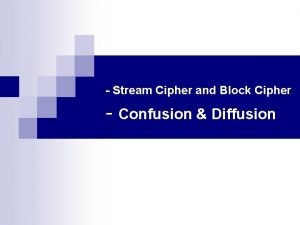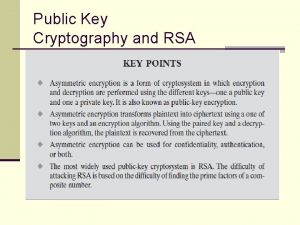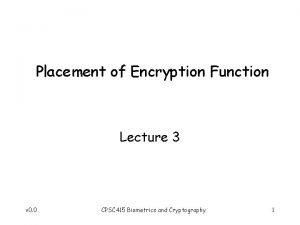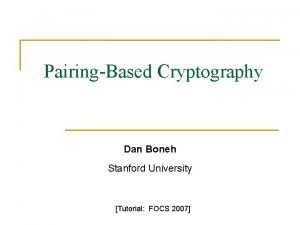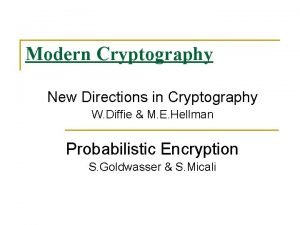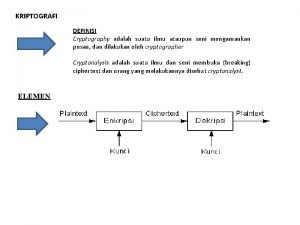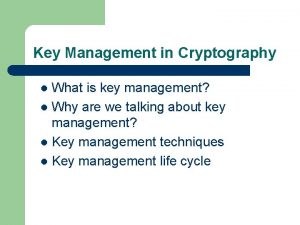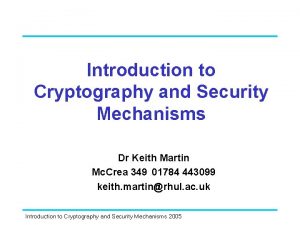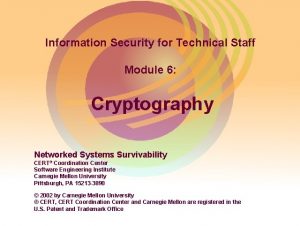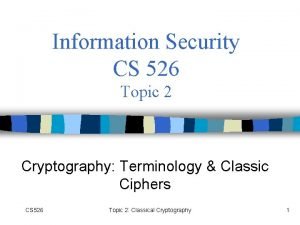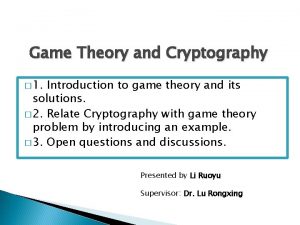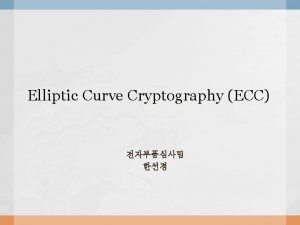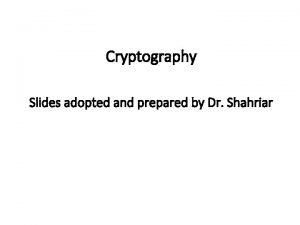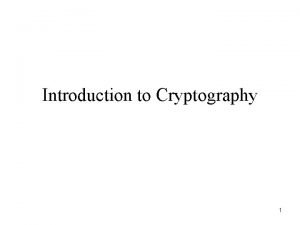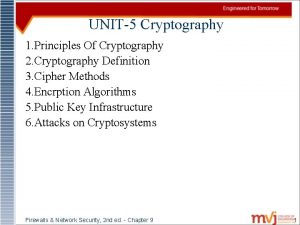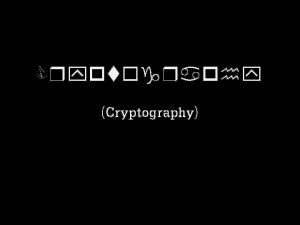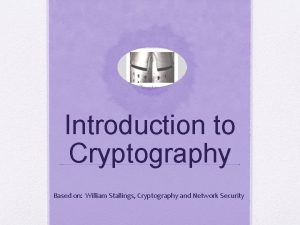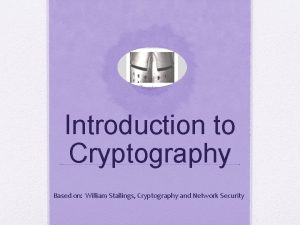Introduction to Cryptography 1 What is Cryptography Cryptography





























- Slides: 29

Introduction to Cryptography (1)

What is Cryptography • Cryptography – In a narrow sense • Mangling information into apparent unintelligibility • Allowing a secret method of un-mangling – In a broader sense • Mathematical techniques related to information security • About secure communication in the presence of adversaries • Cryptanalysis – The study of methods for obtaining the meaning of encrypted information without accessing the secret information • Cryptology – Cryptography + cryptanalysis

Security Attacks • Passive attacks – Obtain message contents – Monitoring traffic flows • Active attacks – – – Masquerade of one entity as some other Replay previous messages Modify messages in transmit Add, delete messages Denial of service

Objectives of Information Security • Confidentiality (secrecy) – Only the sender and intended receiver should be able to understand the contents of the transmitted message • Authentication – Both the sender and receiver need to confirm the identity of other party involved in the communication • Data integrity – The content of their communication is not altered, either maliciously or by accident, in transmission. • Availability – Timely accessibility of data to authorized entities.

Objectives of Information Security • Non-repudiation – An entity is prevented from denying its previous commitments or actions • Access control – An entity cannot access any entity that it is not authorized to. • Anonymity – The identity of an entity if protected from others.

Types of Cryptographic Functions • Secret key functions • Public key functions • Hash functions

Secret Key Cryptography plaintext encryption ciphertext key ciphertext plaintext decryption • Using a single key for encryption/decryption. • The plaintext and the ciphertext having the same size. • Also called symmetric key cryptography

SKC: Security Uses • Transmitting over an insecure channel – The transmitted message is encrypted by the sender and can be decrypted by the receiver, with the same key – Prevent attackers from eavesdropping • Secure storage on insecure media – Data is encrypted before being stored somewhere – Only the entities knowing the key can decrypt it

SKC: Security Uses • Authentication – Strong authentication: proving knowledge of a secret without revealing it. Alice challenge r. A Bob response r. A encrypted with KA, B r. B encrypted with KA, B

SKC: Security Uses • Integrity Check – Noncryptographic checksum • Using a well-known algorithm to map a message (of arbitrary length) to a fixed-length checksum • Protecting against accidental corruption of a message • Example: CRC – Cryptographic checksum • A well-know algorithm • Given a key and a message • The algorithm produces a fixed-length message authentication code (MAC) that is sent with the message

Public Key Cryptography plaintext encryption ciphertext Public key Private key ciphertext plaintext decryption • Each individual has two keys – a private key (d): need not be reveal to anyone – a public key (e): preferably known to the entire world • Public key crypto is also called asymmetric crypto.

PKC: Security Uses • Transmitting over an insecure channel Alice encrypt m. A using e. B Bob encrypt m. A using d. B • Secure storage on insecure media – Data is encrypted with the public key of the source, before being stored somewhere – Nobody else can decrypt it (not knowing the private key of the data source)

PKC: Security Uses • Authentication Alice encrypt r using e. B Bob decrypt to r using d. B r

PKC: Security Uses • Digital Signatures – Proving that a message is generated by a particular individual – Non-repudiation: the signing individual can not be denied, because only him/her knows the private key. plaintext signing Signed message Private key Public key Signed message plaintext verification

Hash Functions • Cryptographic hash function – A mathematical transformation that takes a message of arbitrary length and computes it a fixed-length (short) number. • Properties ( Let the hash of a message m be h(m) ) – For any m, it is relatively easy to compute h(m) – Given h(m), there is no way to find an m that hashes to h(m) in a way that is substantially easier than going through all possible values of m and computing h(m) for each one. – It is computationally infeasible to find two values that hash to the same thing.

Hash Functions: Security Uses • Password hashing – The system store a hash of the password (not the password itself) – When a password is supplied, it computes the password’s hash and compares it with the stored value. • Message integrity – Using cryptographic hash functions to generate a MAC Alice Bob secret message =? hash secret

Hash Functions: Security Uses • Message fingerprint – Save the message digest of the data on a tamper-proof backing store – Periodically re-compute the digest of the data to ensure it is not changed. • Downline load security – Using a hash function to ensure a download program is not modified • Improving signature efficiency – Compute a message digest (using a hash function) and sign that.

Cryptographic Algorithms: Agenda • Attacks on cryptographic algorithms • Definition of security • Some cryptographic algorithms: basic facts

Attacks: Types • Brute force search – Assume either know/recognize plaintext – Simply try every key • Cryptoanalysis – Ciphertext only • With the ciphertext • Plaintext is recognizable – Known plaintext • <cipher, plaintext> pairs are known – Chosen plaintext • Select plaintext and obtain ciphertext to attack

Birthday Attacks • Principle – Assume: A function yields any of n different outputs with equal probability, where n is sufficiently large. – After evaluating the function for about 1. 2*squart(n) arguments, we expect to find a pair of different arguments, x 1 and x 2, such that f(x 1)=f(x 2). • Attack: message replay • Solution: increase the size of the output

Meet-in-the-Middle Attacks • Principle – build a table of keys – Compute f(k, m) for every key • f is an encryption function, m is a known message – Eavesdrop a value f(k’, m) – If f(k’, m)=f(k, m), then there is a good chance k’=k.

Meet-in-the-Middle Attacks • An attack example – Assume: • a new encryption function: F(k 1, k 2, m)=f(k 1, f(k 2, m)) • A pair (P, C) is known – Attacker: • Encrypt P, i. e. , computing f(k 2, P), for all possible values of k 2; store the values in a table • Decrypt C, i. e. , computing f-1(k 1, C), for all possible values of k 1, and for each result check the table • A match reveals a possible combination of the keys

Security Definition • Unconditional Security – The system cannot be defeated, no matter how much power is available by the adversary. • Computational security – The perceived level of computation required to defeat the system using the best known attack exceeds, by a comfortable margin, the computational resources of the hypothesized adversary. – e. g. , given limited computing resources, it takes the age of universe to break cipher.

Security Definition • Provable security – The difficulty of defeating the system can be shown to be essentially as difficult as solving a well-known and supposedly difficult problem (e. g. , integer factorization) • Ad hoc security – Claims of security generally remain questionable – Unforeseen attacks remain a threat

Secret Key Cryptographic Algorithms • DES (Data Encryption Standard) • 3 DES (Triple DES) • IDEA (International Data Encryption Algorithm) • AES (Advanced Encryption Standard)

DES (Data Encryption Standard) • Authors: NSA & IBM, 1977 • Data block size: 64 -bit (64 -bit input, 64 -bit output) • Key size: 56 -bit key • Encryption is fast – DES chips – DES software: a 500 -MIP CPU can encrypt at about 30 K octets per second • Security – No longer considered secure: 56 bit keys are vulnerable to exhaustive search

Triple-DES (3 DES) • C = DESk 3(DESk 2(DESk 1(P))). • Data block size: 64 -bit • Key size: 168 -bit key; effective key size: 112 (due to man-in-the-middle attack) • Encryption is slower than DES • Securer than DES

IDEA (International Data Encryption Algorithm) • Authors: Lai & Massey, 1991 • Data block size: 64 -bit • Key size: 128 -bit • Encryption is slower than DES • Security – Nobody has yet published results on how to break it • Having patent protection

AES (Advanced Encryption Standard) • Authors: Daemen & Rijmen • Block size: 128 -bit • Key size: 128 -bit, 192 -bit, 256 -bit • Encryption is fast • Security – As of 2005, no successful attacks are recognized. – NSA stated it secure enough for non-classified data.
 Security mechanisms in cryptography
Security mechanisms in cryptography Intro to cryptography
Intro to cryptography Victor shoup
Victor shoup Introduction to cryptography and network security
Introduction to cryptography and network security Introduction to cryptography
Introduction to cryptography Introduction to cryptography and network security
Introduction to cryptography and network security Introduction paragraph structure
Introduction paragraph structure New directions in cryptography
New directions in cryptography Define diffusion and confusion
Define diffusion and confusion Blaise de vigenere cryptography
Blaise de vigenere cryptography Principles of public key cryptosystems
Principles of public key cryptosystems Explain about the placement of encryption function.
Explain about the placement of encryption function. Cryptography stanford
Cryptography stanford Online cryptography course
Online cryptography course Wireless security in cryptography
Wireless security in cryptography New directions in cryptography summary
New directions in cryptography summary Cryptography adalah
Cryptography adalah Key management in cryptography
Key management in cryptography Cryptography
Cryptography Module 06 basic cryptography
Module 06 basic cryptography Kerckhoffs’s principle
Kerckhoffs’s principle Cryptography
Cryptography Handbook of applied cryptography
Handbook of applied cryptography Cryptography board game
Cryptography board game Ecdlp
Ecdlp Cryptology
Cryptology Cryptography slides
Cryptography slides Cryptography summary
Cryptography summary A murder has been committed
A murder has been committed Hieroglyphics definition
Hieroglyphics definition








